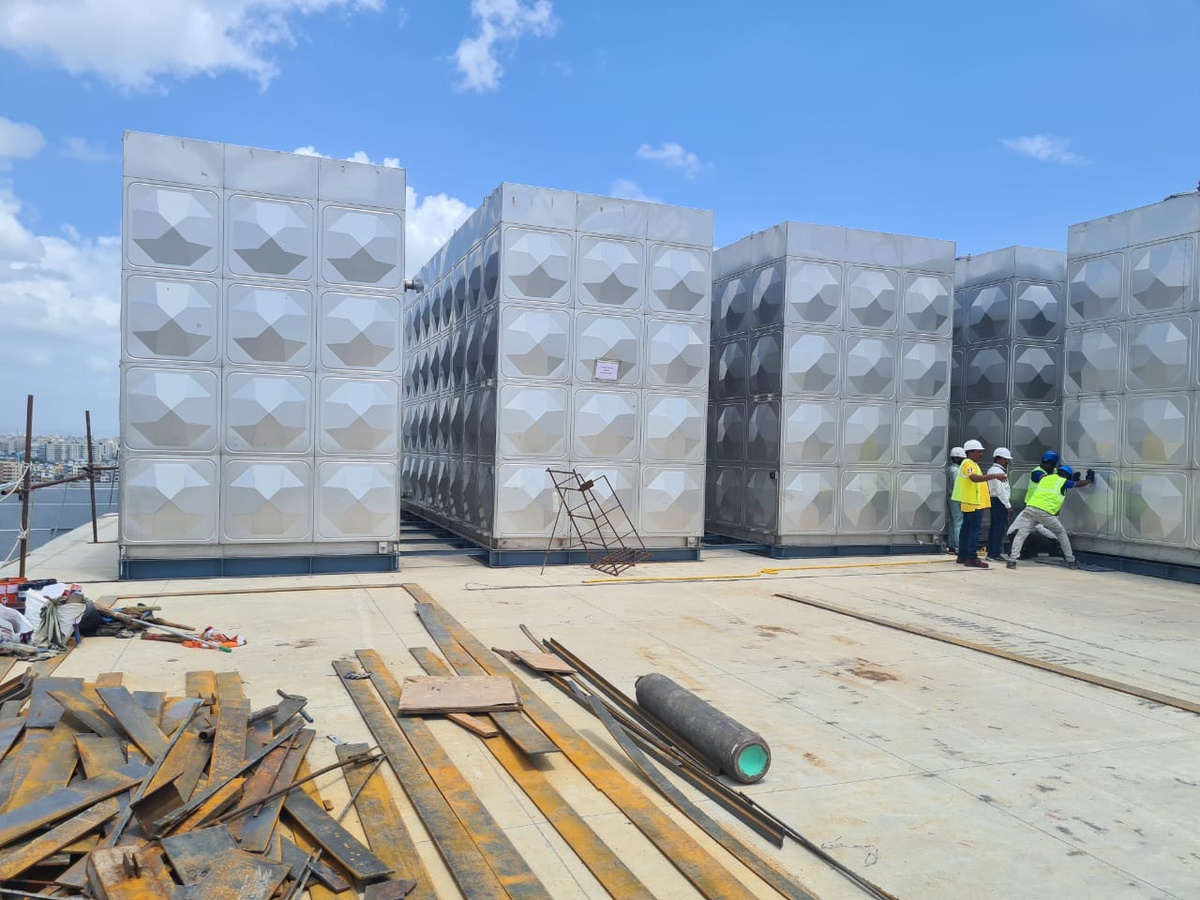Before you purchase the best water tank in India for your home or office, you must be aware of the NBCI guidelines for water storage tanks in India. It would help if you had the following provisions in the building to install a water storage tank.
- Make appropriate arrangements for the supply interrupted by repairs/breakdowns to mains, etc.
- To reduce demand on the main supply.
- To be prepared for the intermittent supply and to maintain enough storage of water for the firefighting requirement of the building.
- According to the National building code of India, the regulatory body for water storage tanks India recommends that the water may be stored in overhead tanks (OHT) or underground tanks (UGT).
What materials should be used for water storage tanks India?
Materials such as reinforced concrete, brick masonry, Ferro cement, mild steel, stainless steel, plastic, or Glass reinforced panels (GRP) can be used to manufacture the best water tank in India. As per NBCI, Tanks made of stainless steel can be welded, riveted, or panel/pressed Construction. It should be galvanized or coated externally with reliable anti-corrosive and weather-resistant paint. Manufacturers cannot use lead-based paint in the tank. Similarly, tanks with a lead lining shall not be used.
Each tank shall include the following fittings for the Construction of the best water tank in India.
Manholes
Enough provisions for manholes for access and repair. Such manholes shall use corrosion-resistant materials like cast iron, reinforced cement concrete, steel fiber reinforced concrete, galvanized steel, high-density polyethene, fiberglass reinforced plastic, or similar materials approved by the authority. Besides, these manholes should be provided with locking arrangements to avoid misuse and tampering.
Ladders
Tanks with a height of 90 cm or more shall be provided with corrosion-resistant ladders to enable a plumber or the mechanic to reach the bottom of the tank for maintenance or repair purposes.
Pipe for overflow
Each tank shall have an overflow pipe above the ground or the terrace level to act as a warning in overflow cases. The size of the overflow pipe shall be larger than the inlet pipe to allow the normal flow. If the inlet pipe diameter is large, the overflow pipes should be more to let the water flow easily.
Vent pipes
Tanks with a capacity of 5000 liters shall include vent pipes to avoid pressure build-up in the tank that might result in the tank's stoppage of water flow or inward collapse.
Connection of overflow and scour pipe
The overflow and scour pipe mustn't be connected to any outside drain, gully trap, or manhole to prevent backflow and contamination of the water. All such connections must be discharged over a grating with an air gap of 50 mm. Additionally the overflow and vent pipes shall be fitted with mosquito-proof brass grating to prevent the breeding of mosquitoes, vermin, and other insects.
Overhead tanks on the terraces or the top of the building shall be supported with a proper structure to transfer the total weight of the tank and the water directly to the structure of the building.
Other important points to remember while installing a water tank
Every water tank should be easily accessible and installed in such a way as to enable routine inspection and cleaning to be carried out.
Ideally, the outlet brass pipe shall include a filter and be fixed at least 5 cm to 7.5 cm above the bottom of the tank.
For overhead tanks, the base of the tank shall be placed clear of the terrace slab so that the elevation difference between the tank's outlet pipe and the highest fixture on the top floor of the building shall be a minimum of 2 meters. It will also help in controlling the leakage into the structural slab.
For the connection of the steel pipe and the storage tank, the end of the pipe shall be screwed and secured through back nuts from both inside and outside. A connector made of non-ferrous material shall be used for joining copper pipe to a tank made of copper or steel.
Are there any regulations or guidelines for installing water storage tanks in India?
In the last couple of decades, there has been a massive increase in the country's urban population. Groundwater quality has severely deteriorated, contaminated and even become toxic in a few places. Therefore, the water source and overall quality of water storage tanks India play a very important role. NBCI guidelines relate to the sources and quality every user needs to follow.
Source of water
The best water source is rainfall; collecting it before it reaches the ground is recommended. Hence, rainwater harvesting is an ideal solution. As per government guidelines, every residential society must provide rainwater harvesting facilities.
Quality of water
Water contamination can occur both in the source of origin and during the distribution process after water treatment has already taken place. Water contamination has several reasons, including naturally occurring chemicals like arsenic, radon, uranium, and minerals. Besides, it can also be caused by fertilizers, pesticides, concentrated animal feeding operations, sewer overflow, or wastewater releases. Such contaminants in water can cause serious health problems such as gastrointestinal illness, reproductive issues, and neurological disorders.
NBCI guidelines suggest that water stored in tanks shall be free from pathogenic organisms. It should be transparent and free from undesirable odors and minerals that could cause adverse effects on people's health. Therefore, you may install the best water tank in India but it’s equally important to follow the necessary guidelines.


No comments yet